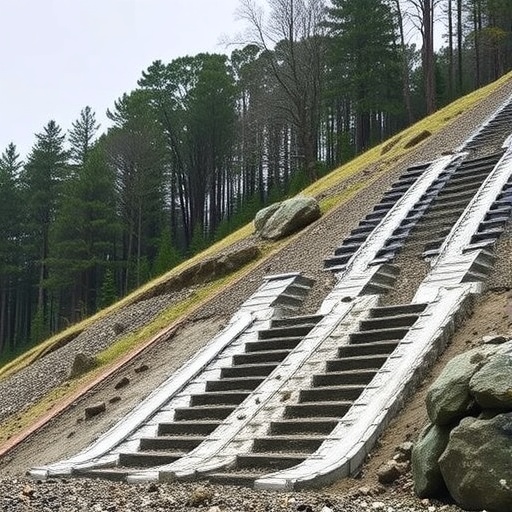In a groundbreaking development poised to transform geotechnical engineering, researchers have unveiled a simplified yet robust method for evaluating the stability of finite slopes subjected to rainfall. This innovative approach, detailed in a recent publication in Environmental Earth Sciences, addresses one of the most critical challenges in slope stability analysis—accurately predicting failure under fluctuating hydrological conditions. As slopes worldwide face increasing threats from intensified rainfall patterns exacerbated by climate change, the implications of this research resonate far beyond academic circles, impacting infrastructure safety, disaster mitigation, and urban planning.
Traditionally, slope stability assessments have relied on complex numerical models that integrate various parameters including soil mechanics, hydrology, and external forces. These models, although precise in theory, demand extensive field data and computational resources, often rendering them impractical for routine engineering purposes. The newly proposed method, however, strikes a compelling balance between simplicity and accuracy, reducing the analytical burden without sacrificing critical insights into slope behavior under rain-induced stress.
Central to this method is the conceptualization of finite slopes as discrete systems whose mechanical response to rainfall infiltration can be modeled through a set of streamlined equations. By focusing on the essential physical processes—namely, pore water pressure dynamics, shear strength degradation, and seepage forces—the approach enables engineers to rapidly approximate the factor of safety for slopes exposed to varying rainfall intensities and durations. This not only accelerates decision-making processes but also enhances predictive reliability in real-world scenarios.
What sets this methodology apart is its adaptability to different soil types and slope geometries. The researchers have incorporated parameter calibration strategies that allow the model to be fine-tuned based on relatively minimal field testing, such as standard penetration tests and basic hydraulic conductivity measurements. This flexibility ensures that the method can be deployed across diverse environmental settings, from mountainous terrains to urban embankments, without the need for exhaustive site-specific data collection.
Rainfall-induced slope failures have long been a source of concern, especially in regions where monsoonal climates or sudden storm events are prevalent. Such failures often result in catastrophic economic losses and endanger human lives. The complexity arises because rainfall infiltration alters the hydrological state of the soil, increasing pore water pressures and reducing effective stress, which in turn diminishes soil shear strength. The presented method captures these interactions more efficiently by utilizing an integrated hydromechanical model that links rainfall infiltration parameters directly to stability indices.
Beyond its academic merit, the study offers tangible tools for practitioners. The researchers provide a step-by-step framework that can be implemented using standard engineering software or even spreadsheet calculations, making the technique accessible to field engineers and consultants. By minimizing technical barriers, this initiative democratizes slope stability analysis, empowering regions with limited resources to better anticipate landslide risks.
One notable innovation is the incorporation of transient rainfall events rather than steady-state assumptions, which have traditionally limited model responsiveness. By allowing for dynamic infiltration rates and temporally variable boundary conditions, the method mirrors real meteorological processes with greater fidelity. This temporal sensitivity enhances predictive capability, enabling early warning systems to be more effective in forecasting imminent slope failures.
Moreover, the validation of this approach involved extensive numerical simulations and case studies based on historical rainfall-triggered landslides. The results affirmed the model’s accuracy, showing strong correlation between predicted safety factors and observed slope performances. This reinforces confidence that the simplified method does not compromise theoretical rigor despite its streamlined nature.
The implications extend into infrastructure design and maintenance regimes. Engineers can now incorporate this method into slope monitoring systems to continuously evaluate stability as rainfall events unfold, facilitating proactive maintenance and hazard mitigation. Additionally, urban planners can utilize the insights to inform zoning regulations and land-use policies, particularly in susceptible areas where development pressure conflicts with natural terrain risks.
An exciting aspect of the research is its potential compatibility with emerging remote sensing technologies, such as satellite-based rainfall estimation and ground-based moisture sensors. When integrated with these data sources, the model could form the basis of real-time risk assessment platforms, delivering actionable intelligence to emergency response teams and local authorities.
From an environmental perspective, understanding the mechanics of rainfall-induced slope failures also links to broader ecological concerns. Slope collapses can trigger downstream sedimentation, affecting water quality and aquatic habitats. By enabling better predictive models, stakeholders can anticipate and mitigate environmental consequences, aligning engineering practice with sustainability goals.
In summary, this study heralds a significant advance in slope stability analysis by delivering a simplified yet scientifically robust method attuned to rainfall impacts. Its combination of theoretical soundness, practical usability, and adaptability positions it as a vital tool for safeguarding communities and infrastructure in an era of climate uncertainty.
As the frequency and intensity of heavy rainfall increase globally, the importance of such innovative approaches cannot be overstated. They not only reduce the risk of catastrophic slope failures but also offer a scalable solution adaptable to the wide variety of geological and climatic conditions encountered worldwide. Future research may build upon this foundation by integrating machine learning algorithms or exploring multisource data fusion to further enhance predictive precision.
Ultimately, the research embodies the convergence of geotechnical science, hydrology, and applied mathematics, demonstrating how interdisciplinary efforts can yield solutions that are both sophisticated and accessible. The roadway to safer slopes and resilient landscapes may be complex, but this breakthrough method brings clarity—and hope—by simplifying a traditionally formidable problem without compromising on scientific integrity.
Subject of Research: Stability assessment of finite slopes under the influence of rainfall infiltration.
Article Title: A simplified method for evaluating the stability of finite slopes subjected to rainfall.
Article References:
Gu, H., Yang, K., Jiang, X. et al. A simplified method for evaluating the stability of finite slopes subjected to rainfall. Environmental Earth Sciences, 84, 682 (2025). https://doi.org/10.1007/s12665-025-12673-8
Image Credits: AI Generated




